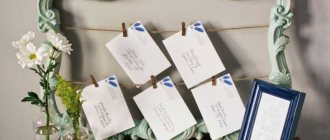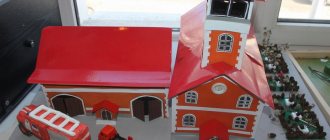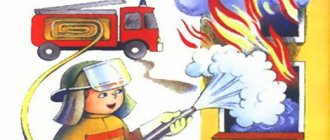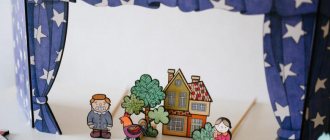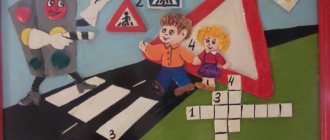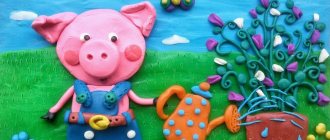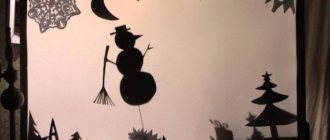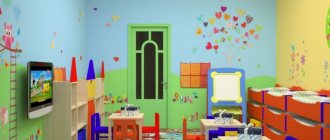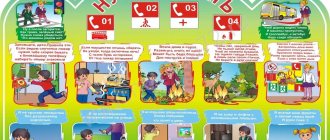How to achieve information content when creating a stand?
It is better to make do-it-yourself stands for a kindergarten according to a strictly defined plan:
- At the top is a heading, written or printed large, in a straight line or with a curved base;
- Below the title are images. They should be placed across the entire width of the poster or a space should be made for words (depending on the volume of text);
- Below the pictures are direct congratulations and wishes, in prose or poetic form;
- Below is the signature (“kindergarten administration”, “Your teachers”, “Your parents”, etc.).
What to tell children about summer
The main “summer” topics that can be used for conversations with children are:
- vegetables fruits;
- berries, mushrooms;
- insects, birds, animals;
- people's activities in the garden, in the forest;
- types of outdoor recreation (travel to the sea, summer sports);
- safety of children in summer.
The first of these sections are suitable for toddlers, and the rest for older preschoolers. They allow you to select pictures about summer for both very young children and future first-graders. You can use both subject images (berries, flowers, sandbox toys) and subject compositions:
- “The first day of summer has arrived!”;
- “What do children play outdoors in the summer?”;
- “What are the rules of behavior on the water and why are they needed?”
Properly selected illustrations help increase the effectiveness of speech development exercises and make them more interesting. Various pictures about summer are excellent visual material that makes it possible to conduct useful activities, as well as exciting games with preschoolers of different ages.
Work in the garden
Fauna Russia Day
Outdoor games
Walk in the woods
Children care about nature
Visibility and its implementation
For a stand to be perceived as an interior decoration, it must be in harmony with it. You should not focus only on the informative part. Pictures, images, photographs are required next to the inscriptions on the stand.
If the stand is dedicated to the New Year celebration, it must have a decorated Christmas tree. If March 8 - mimosa or a bouquet of other flowers. If it's Mother's Day - an image of a woman's face with a smile.
A bright background created by completely covering the surface with colored paper or painting it with paints will help provide clarity.
Teaching children in the summer - hardworking bees
During the summer months we often hear the buzzing of bees, so create an information display to teach children about bees. Name your stand Busy Bees, Buzzing Around, or Bee Jobs. Display a large hive with bees surrounding it on your information display, or decorate the display with different colors and place a bee next to each flower and some information about these insects next to it. Teach children where bees live, what they produce, what color they are, and even include information about how to avoid a bee sting or what to do if you get stung by a bee.
Clarity and its personification
Do not forget that the stand is made, first of all, for the audience. Both adults and small children can act as them. They understand vivid images - Father Frost, Snow Maiden, a fireman in uniform, etc., numbers that carry meaning (31, 23, 8). Symbols and branding are best left for other purposes.
The title should be as accurate and succinct as possible. There is no need to make it poetic or burden it with epithets: it is more important for children what kind of holiday they are preparing to celebrate.
Teaching children summer safety in the sun
The summer months bring heat and sun, which can be dangerous for children who are not dressed properly or not hydrated enough. Create an informational display on "Sun Safety" or "Safe Summer Fun" to give kids some safety tips that they can even share with their parents. Accompany each tip with a picture to make it clear. Teaching children about sun safety in the summer can be summed up by the following tips: “wear a bucket hat,” “use sunscreen and parasols,” “carry a water bottle or take breaks from play to drink,” and “wear sunglasses.” .
The principle of accessibility: “let me touch it!”
If the stand is placed in a kindergarten or school classroom, children will inevitably become overly curious. Some people will want to take a closer look, and some will want to touch it. So that the result of creativity does not go to waste in the very first minutes of public viewing, you need to make it tangible.
For example:
- Attach felt leaves in yellow and orange tones to the stand for Autumn Day,
- For a stand in honor of Easter, attach a wicker surface that imitates a basket, or an eggshell, painted in different shades,
- Decorate the stand dedicated to May 9 with real St. George ribbons and carnations cut out of red corrugated paper.
A DIY children's educational stand is a prime example of accessibility. Its design depends on the age of the children for whom it is intended.
Such a busy board will help develop curiosity and promote exploration of the world around us.
For children 2-3 years old, felt flowers and trees of different shades and shapes will do.
The middle group can enjoy the following attached to the stand:
- Cubes,
- Pyramids,
- For an hour.
For members of the preparatory group - letters and road signs, tiny tools or any other gizmos from everyday life:
- Landline phone dial,
- Mixer valve,
- Door knob,
- Espagnolette,
- Chain,
- Old calculator,
- Wheel,
- Compass,
- Klaxon, etc.
Information stand for parents “Children’s Summer Holidays”
summer holiday for children
Summer is not only a time for travel, but also the most favorable time for children to relax, harden and improve their health.
Therefore, it is very important that parents make the most of this precious time. At the same time, many questions arise about how best to do this.
The sun is good, but in moderation
In summer, children should spend maximum time outdoors. However, if older preschoolers are allowed to sunbathe a little, then direct sunlight can cause harm to children. The biggest danger is overheating of the body, sunburn, sunstroke, since a small child has less perfect thermoregulation and his skin is very delicate.
Light-air baths can be carried out under a canopy or in the shade of trees. In this case, the principle of gradual exposure of the child’s body must be observed. First, the arms and legs are freed from clothing, and then the rest of the body. The time of light-air baths gradually increases to 30-40 minutes.
Such baths are especially recommended for children with weakened bodies. The best time is from 9 to 12 o'clock, in the south - from 8 to 10 o'clock. It is best to end each light-air bath with a water procedure.
After a week-long course of light-air baths, preschool children can begin sunbathing. A child can sunbathe while lying down, or even better while playing and on the move.
Sunbathing in combination with light-air baths, as well as water procedures, has an excellent strengthening effect. Children become more resistant to influenza-like illnesses than those children who sunbathed little.
Caution: heat and sunstroke!
Experts do not make much difference between these conditions. And this is understandable.
The basis of both heatstroke and sunstroke is overheating of the body. The cause of heat stroke is the difficulty of heat transfer from the surface of the body. This is often associated with prolonged exposure to a hot, humid atmosphere. When sunstroke occurs, blood circulation in the brain is impaired. This usually happens when a child walks in the sun with his head uncovered.
The younger the child is, the more sensitive he is to the effects of heat and sunlight. Therefore, overheating of the body in a small child can sometimes already occur while taking light-air baths.
With mild sunstroke or heatstroke, the symptoms are mostly the same. These are dizziness, weakness, headache. In severe cases, convulsions, vomiting, and loss of consciousness may occur. In all such situations, you need to urgently call a doctor, and before he arrives, move the child to the shade, wet his head and chest with cold water, put a cold compress on the bridge of his nose, and raise his head. Give the child something to drink and calm him down.
Bathing is an excellent hardening agent
You can swim in open water starting from the age of two.
The swimming area should be shallow, level, and with a slow current.
Before giving your child the opportunity to independently enter the water, you need to make sure that there are no holes, deep mud, snags, or sharp stones in this place.
An adult must be in the water with the child.
When swimming, you must follow the following rules:
- It is not allowed to swim on an empty stomach or earlier than 1-1.5 hours after eating.
- Children should be in motion in the water.
- If you feel chills, get out of the water immediately.
- You should not plunge into cool water while hot.
Unusual solutions for ordinary stands
A collage is the best option if you have to prepare a stand with your child as an assignment for a group celebration or to participate in a competition.
Unlimited creative freedom:
- You can include any newspaper cutouts in your collage,
- Magazines,
- Advertising pictures,
- Suitable for the topic.
The following can be glued to the stand sheet:
- Natural materials (dried leaves, small pebbles),
- Applications made of paper (snowflakes or flowers) or fabric (felt, knitted fabric),
- Handicraft small items (bugle beads, beads, beads, threads of yarn, pompoms);
You can also make stands for children's crafts with your own hands. It can be called “Our Vernissage” or “Exhibition of Crafts”.
- To attach drawings to the stand, you can use pins or magnets. To demonstrate three-dimensional crafts (made of plasticine, cardboard, corrugation, etc.) - paper or knitted “pockets”;
- temporary stand, or stand-template. This will be convenient when you need to impromptu prepare for a celebration or when there is absolutely no time to decorate the group.
- For it you will need: self-adhesive letters (the entire alphabet) and numbers, button magnets, double-sided tape, a sponge (to give volume to the inscriptions), universal pictures (flowers, leaves, candles, stars, etc.);
- DIY information stands for kindergarten differ from all others by the presence of plastic frames or “pockets” for placing official information concerning parents.
- In all other respects, they should serve as decoration for a children's group: have a bright design with expressive characters - Leopold the cat, Carlson, a train, a hedgehog, a daisy, etc.
Such boards can be made in an unusual shape - in the form of a cloud or a light, a star or a sun - this way they will quickly attract the attention of parents.
Ideas for decorating the stand base
The design of the base is solely the author's decision.
Here you can use all your imagination and use the most unexpected materials and color solutions.
Despite this, there are some time-tested developments by professional designers and home craftsmen.
Stand markings
In order for the information to be easily perceived, you need to correctly mark the front side of the product. The effectiveness of the information panel will depend on the location of the pockets and inscriptions. There are a few basic recommendations to keep in mind here:
- with a clear division into zones, the reader can immediately go to the information he is interested in;
- a large number of pictures and other design solutions distracts the reader and scatters his attention. That is why you should not overuse decorative elements;
- the main information should be highlighted in large font. In addition, it should be possible to quickly replace outdated information;
- only relevant information should be posted in thematic areas;
- photographs, drawings and working copies of a particular manufacturer can be placed in the exhibition area.
Plexiglas pockets
One of the most affordable options for arranging information pockets is to use standard office files. They are attached to the front panel using glue or double-sided tape.
To make the product more presentable, it is advisable to make information windows yourself. This will require additional effort and materials, but will add originality and style to the finished product. To make pockets for announcements with your own hands you need:
- Draw the outline of the future cell onto an existing sheet of plexiglass. Its standard dimensions correspond to A4 format (210x297 mm), plus 10-15 mm on the left and right sides.
- Use a hacksaw or jigsaw to cut out the workpiece. To ensure smooth insertion and removal of sheets, cut off a corner of any size on one side of the rectangle.
- After this, strips need to be cut from the remaining plexiglass. Their width will determine how much the pocket deviates from the front plane, and their length will correspond to the dimensions of the previously cut workpiece.
- Glue the strips to the workpiece on three sides. The exception is its upper edge.
- Glue the pocket thus obtained to the shield according to the markings.
Thus, by spending very little time, you can significantly increase the aesthetic characteristics of your stand.
Wooden frame
Frames made of natural wood allow you to give your stand an original and presentable appearance. Both a baguette and any other profile can be used as blanks. In some cases, even an ordinary beam attracts the attention of readers.
The wooden frame can be attached to the front panel either with glue or with self-tapping screws on the back side.
For greater attractiveness, the wood can be treated with stain and varnished.
Using different colors
Another important point in stand design is the use of different colors. Using color solutions you can significantly increase the attractiveness of your stand.
There are several classic options for designing information panels. For elementary schools, the most commonly used colors are green and orange.
Middle school students respond more to blue and yellow colors. High school students more often pay attention to information posted on red and blue stands.
If, despite all efforts, the stand does not attract the attention it deserves, you should pay attention to the following:
- information submission form;
- font size;
- frequency of information replacement;
- stand location.
To increase the popularity of the information panel, it is also advisable to study the experience of more successful colleagues whose stands constantly attract the attention of readers.
